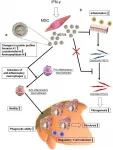(Press-News.org) Niigata, Japan--Researchers from Niigata University , the University of Tokyo, Osaka University and Tokyo Medical University, Japan have developed a new approach that could revolutionize the treatment, prevention, and possibly reversal of the damages caused by liver diseases. This novel strategy exploits small extracellular vesicles (sEVs) derived from interferon-γ (IFN-γ) pre-conditioned MSCs (γ-sEVs).
Cirrhosis and other chronic liver diseases remain a global health concern, with close to 2 million deaths reported annually, these account for approximately 3.5% of annual worldwide deaths. All these statistics are largely driven by the fact that 75 million of the 2 billion people who consume alcohol worldwide are diagnosed with alcohol-use disorders and are at risk of developing alcohol- induced liver disease. In addition, the high prevalence of viral hepatitis-induced liver damage continues to be on the rise.
These sobering numbers inspired a team of scientists led by Prof. Shuji Terai of the Division of Gastroenterology and Hepatology, Graduate School of Medical and Dental Sciences, Niigata University, to build upon previous knowledge that the ability to control fibrosis--which is the development of fibrous connective tissue as a reparative response to injury or damage--in livers under advanced cirrhosis, is often lost. In an interview Prof. Terai said, "Our results showed that modified extracellular vesicles can become a new therapeutic strategy for liver cirrhosis"
Since clinically advanced cirrhosis is an end-stage disease that can effectively be treated only by liver transplantation at present, there is a race in the field with many scientists developing targeted therapies for modulating fibrosis and aiding tissue regeneration.
One of the most popular approaches is cell therapy, where mesenchymal stromal cells (MSCs) and macrophages have shown potential towards inducing liver fibrosis regression. The popularity of this approach is centered on its cost-effectiveness; because MSCs are not only obtainable from the bone marrow, but also from medical waste that include umbilical cord tissue, adipose tissue, and dental pulp. Apart from the ease of availability, MSCs can also be grown relatively easily in the lab. Furthermore, rather than acting directly by replacing the damaged tissues, MSCs have previously been shown to be medical signaling cells that indirectly produce cytokines, chemokines, growth factors, and exosomes that are crucial for repairing and regenerating damaged tissue. Over the years, considerable progress has been made towards capacity building for research and clinical trials for novel treatment strategies against liver diseases. This is exemplified by previous demonstrations that MSCs have anti-inflammatory, anti-fibrotic, and anti-oxidative effects through these humoral factors. Despite tissue rejection being one of the barriers to cell/tissue transplantation interventions; MSCs are attractive for possessing low immunogenicity, and this can facilitate their use for both autologous (same individual) and allogeneic (different individuals of the same species) transplantation, as evidenced by applications in nearly 1000 clinical trials involving other fields, including the treatment of liver diseases.
In a series of experimental mice studies, this team of researchers, from Niigata University , the University of Tokyo, Osaka University and Tokyo Medical University, Japan may have discovered that IFN-γ pre-conditioned human AD-MSC-derived sEVs (AD-MSC-γ-sEVs) can induce anti-inflammatory macrophage counts, which are the key players in tissue repair, including the regression of fibrosis and promotion of tissue regeneration in vitro.
They report that both human adipose tissue-derived MSCs (AD-MSC-sEVs) and AD-MSC-γ-sEVs can promote macrophage motility and phagocytic activity. In addition, they also show that AD-MSC-γ- sEVs contain anti-inflammatory macrophage inducible proteins and can effectively control inflammation and fibrosis in a mouse model of cirrhosis. Following single-cell RNA-seq application, they confirmed AD-MSC-γ-sEVs therapy can induce multidimensional transcriptional changes. Taken together, these results suggest that AD-MSC-derived sEVs can affect the shape and function of macrophages and effectively recruit them into damaged areas, thereby promoting damaged liver tissue repair.
In an interview, Dr. Atsunori Tsuchiya of the Division of Gastroenterology and Hepatology, Graduate School of Medical and Dental Sciences, Niigata University, who was part of the research team said, "Both mesenchymal stromal cells and macrophages are reported to have therapeutic effects for liver cirrhosis, however relationship of both cells and mechanisms of action was not clear. We challenged this problem". He went on to add, "We found the important fact that extracellular vesicles from interferon-γ can induce the tissue repair macrophages, which can regress fibrosis and promote liver regeneration effectively". These words were also echoed by Dr. Suguru Takeuchi of the Division of Gastroenterology and Hepatology, Graduate School of Medical and Dental Sciences, Niigata University, who was also part of the research team, "In our previous study, we reported that intravenous administration of mesenchymal stromal cells migrated to the lung, can work as "conducting cells" and affect to macrophages " working cells" in the liver." "In this study we first elucidated that extracellular vesicles from mesenchymal stromal cells are key molecules to affect the macrophages", added Dr. Takeuchi.
This proof-of-concept pilot study that complements macrophage therapy, holds potential as a strategy for treating liver diseases using IFN-γ pre-conditioned sEVs. However, further development and determination of the mechanisms underlying Treg cell count induction by IFN-γ pre-conditioned MSCs and sEVs still form part of their future research plans before these findings can be translated to humans in phased and controlled clinical trials.
INFORMATION:
The article "Small extracellular vesicles derived from interferon-γ pre-conditioned mesenchymal stromal cells effectively treat liver fibrosis" was published in npj Regenerative Medicine at DOI: 10.1038/s41536-021-00132-4
Researchers from University of Arizona and University of Utah published a new paper in the Journal of Marketing that examines why most scholarly research is misinterpreted by the public or never escapes the ivory tower and suggests that such research gets lost in abstract, technical, and passive prose.
The study, forthcoming in the Journal of Marketing, is titled "Marketing Ideas: How to Write Research Articles that Readers Understand and Cite" and is authored by Nooshin L. Warren, Matthew Farmer, Tiany Gu, and Caleb Warren.
From developing vaccines to nudging people to eat less, scholars conduct research that could change the world, but most of their ideas either are misinterpreted by the public or never escape the ivory tower.
Why does most academic ...
Supporting female survivors of childhood maltreatment is critical to disrupting intergenerational abuse as new research from the University of South Australia shows a clear link between parents who have suffered abuse and the likelihood of their children suffering the same fate.
The finding amplifies an acute need for far better support for victims of child maltreatment to ensure safer and more nurturing environments for all children.
Funded by the NHMRC and the Channel 7 Children's Research Foundation, and published in The Lancet Public Health today, the study found that most child maltreatment is occurring among families caught up in intergenerational cycles of child abuse and neglect - 83 per cent of ...
Largest study so far of more than 17 million adults in England confirms that minority ethnic groups had a higher risk of testing positive, hospitalisation, admission to intensive care units (ICU), and death from COVID-19 compared with white groups, even after accounting for other factors known to increase risk like deprivation, occupation, household size and underlying health conditions.
Disparities for hospitalisation and death lessened for most minority ethnic groups between pandemic waves 1 (February to September 2020) and wave 2 (September to December 2020), but increased for South Asian groups.
To tackle ethnic disparities in COVID-19 risks, the authors call for reducing structural disadvantage and inequality, improving quality of and access to healthcare, and improving uptake ...
HOUSTON ? A Phase II trial led by researchers at The University of Texas MD Anderson Cancer Center found that BK virus (BKV)-specific T cells from healthy donors were safe and effective as an off-the-shelf therapy for BKV-associated hemorrhagic cystitis (BKV-HC), a painful complication common after allogeneic stem cell transplants for patients with leukemia or lymphoma. The study was published today in the Journal of Clinical Oncology.
Infusion of T cells targeting BKV resulted in rapid responses, with 67.7% of patients seeing a complete or partial improvement in symptoms after 14 days. This increased to 81.6% of patients after 28 days post-infusion. No cases of grade ...
The marine worm Ramisyllis multicaudata, which lives within the internal canals of a sponge, is one of only two such species possessing a branching body, with one head and multiple posterior ends. An international research team led by the Universities of Göttingen and Madrid is the first to describe the internal anatomy of this intriguing animal. The researchers discovered that the complex body of this worm spreads extensively in the canals of their host sponges. In addition, they describe the anatomical details and nervous system of its unusual reproductive ...
Scientists from several hospitals and research centers have shown what happens in individual cells of patients who died of COVID-19. In a study published in Nature, the researchers describe how infected cells from multiple organs exhibited a range of molecular and genomic changes. They also saw signs of multiple, unsuccessful attempts by the lungs to repair themselves in response to respiratory failure, which is the leading cause of death in COVID-19 patients.
"You really feel the tragedy of the disease when you see that result," said Aviv Regev, co-senior author of the study and a core institute member at the Broad Institute of MIT and Harvard when the study began. "The lung tries everything at its disposal, and it still can't fix itself. This was a very ...
HOUSTON - (April 30, 2021) - The microscopic structures and properties of materials are intimately linked, and customizing them is a challenge. Rice University engineers are determined to simplify the process through machine learning.
To that end, the Rice lab of materials scientist Ming Tang, in collaboration with physicist Fei Zhou at Lawrence Livermore National Laboratory, introduced a technique to predict the evolution of microstructures -- structural features between 10 nanometers and 100 microns -- in materials.
Their open-access paper in the Cell Press journal Patterns shows how neural networks ...
CHARLOTTESVILLE, Va. - In 2018, industry and academic researchers revealed a potentially devastating hardware flaw that made computers and other devices worldwide vulnerable to attack.
Researchers named the vulnerability END ...
CHICAGO --- Itch torments its sufferers and can be as debilitating as chronic pain.
But it's a hard symptom to measure -- particularly for the 10 million U.S. children with atopic dermatitis, also known as eczema. They can't always verbalize or quantify their suffering via a survey or scale.
It can also be difficult to objectively measure itch for adults with liver disease, kidney disease and certain cancers who experience its symptoms.
So, it's hard to track how well treatments and drugs are working.
But now there is a soft, wearable sensor that actually quantifies itch by measuring scratching when placed on the hand developed by Northwestern University scientists. While it was tested ...
Boston, MA (April 30, 2021) - A new study, presented today at the AATS 101st Annual Meeting, shows significant reduction in post-operative use of Schedule II opioids for pain management following robotic surgery. To address the on-going issues of opioid overuse and abuse, the study aimed to examine the use of painkillers in Enhanced Recovery After Thoracic Surgery (ERATS) protocols and determine the impact of alternative pain management approaches on clinical outcomes.
An Institutional Review Board-approved retrospective analysis of a prospectively maintained ...



